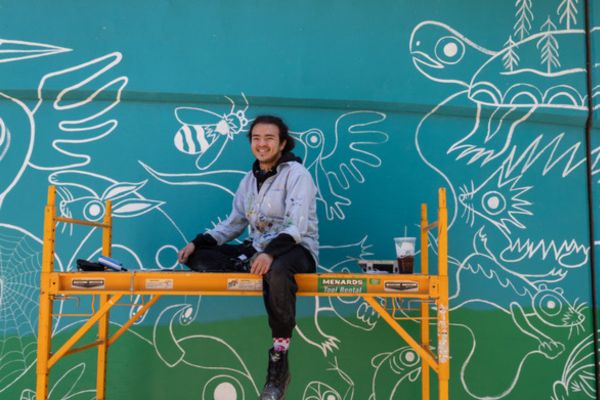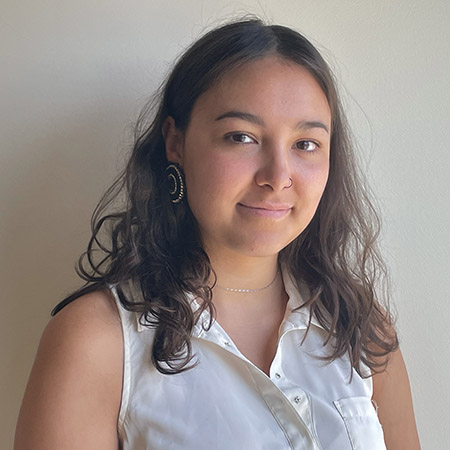
- Details
- By Neely Bardwell
This Pride Month, Native News Online spoke with LGBTQ and two-spirit relatives to get their perspectives on what it means to identify as queer in Indian Country, finding joy through cultural connection, and what they hope for the next generation of LGTBQ and two spirit Indigenous peoples.
The following interview is with Jamie John, a Grand Traverse Band of Ottawa and Chippewa Indians citizen. John is a two-spirit, trans and queer multidisciplinary artist, powwow dancer, and water carrier through the Midewin Lodge.
This interview has been edited for clarity and length.
What does the two-spirit identity mean to you?
This will be my own personal definition, and I do that just to say that I don’t speak for other two-spirit people, and I don’t speak for two-spirit people of different nations. Being two-spirit is being able to live as both having the responsibilities and the teachings and taking up the ceremonial space of both our men and our women.
I can be trans and trans-masculine and be a jingle dress dancer, or still be a water carrier or be able to tend fire but also serve at my ghost suppers, or to sit in women’s and two-spirits’ Lodges. But also doing my sort of ceremonies for a young male person as far as fasting and things of that nature. Being two-spirit is honoring the masculine and the feminine and everything in between.
What does Pride mean to you as an Indigenous person?
So I think June is particularly, for lack of a word, tenuous. Being that it is Indigenous Peoples’ Month and the month of Pride, commemorating the protest and rebellion of Stonewall in New York in the 60s. I think that overall, Pride Month has sort of become like an opportunity for Rainbow capitalists to sort of latch on to our movements for queer and trans liberation and has co-opted the ways that we have sought to get justice, and that makes me sad.
It also makes me kind of angry because I want to emphasize that the roots of anti-queer attitudes, the roots of homophobia and transphobia, and the oppression that we are often facing through the legislature, ignorance, through medical negligence all stem from this desire to strip away bodily autonomy from those whose genders cannot be policed, which has increased the violence that has been occurring since European arrival, especially to our trans and two-spirit, queer, and even our cis-women who have taken up more masculine roles, and in Indigenous societies.
So being able to get to the root of trans liberation being tied to anti-colonial movements, disability justice being tied to trans liberation, which requires the liberation of Black trans women, which requires prison abolition, which requires uplifting our Black relatives through mutual aid, through fundraising efforts to advocate for trans safety. And I think that if we were to identify the roots of all these things as colonialism and capitalism being as intertwined as they are, I think that we would have a much better time at Pride celebrations.
I didn’t go to very many Pride events this year because I live in quite a rural town. I am very openly trans. I write about being trans. I make art about being trans and queer, and I live in a not conservative town, but its progressives are certainly lacking in meaningful action. Those conservative attitudes still permeate throughout the culture of where I’m currently living, where I call home, and I kind of don't feel safe going to many Pride events.
But that being said, I think that being out and being able to speak about these things makes me hopeful for other trans people, for other Native trans people, and for other Native Indigenous queers like me. I want to be able to offer them a sense of safety or a sense of support or offer them — someone to look at who has transitioned or who is openly talking about transition or queerness but is still very deeply connected to where they’re from, to their nation, to their family.
What makes you feel the most authentic?
I think being able to connect in my wholeness with other queer Indigenous people and trans-Indigenous people. It’s nice to be seen as a whole, instead of just a part or as neither. I don’t have to worry about being perceived as male or female because we don’t really have those strict notions. We’ve done our own work to undo those things. I feel safe, and my cultural protocols are honored, and I’m recognized for where I am and who I come from as an Anishinaabe person. And those relationships are just different because you have those multiple points of connection. I think being able to have those makes me feel authentic.
What are some challenges you face as a two-spirit/queer indigenous person?
There are strict gender roles that have been passed down, and they don’t really sort of interrogate or question why or where those binaries came from, and it leads to a lot of denial —. the denial of trans and Two Spirit, Native people and their right to be in a ceremony the way that they would like to be. It denies them their fullness and their two-spiritedness. Choosing to only honor a part of your Spirit is not really honoring the Spirit at all.
I’m a powwow dancer. Gendered categories always kind of rubbed me the wrong way. I wouldn’t call myself a women’s jingle dress dancer because I’m not really a woman, but there’s no male jingle dress dancer category. Would I even fit there if I were to call myself that? Those are sort of the things that we face inside of the community.
Outside of the community, I think there are many different issues. I think, and this might just be my opinion, but I think that two spirit is a term that should be used only for Indigenous people. I think this because we, through language loss, land loss, through cultural and tribal erasure, have lost a lot of our understanding of these ceremonial roles that two-spirit and trans people are reclaiming now. We’ve lost a lot of our understanding of how these people fulfill their roles in the community. We didn’t lose it, but it has been intentionally buried for a long time.
And two-spirit is the beginning of our way and our word to take those things back for ourselves. So that’s a word for Indigenous people only, and I would like to keep it that way. I know it’s not perfect, but it is the one that I like to use for myself. I feel that the word faces a lot of misunderstanding and gets kind of misconstrued with just transgender, or just queer, or you have to look a certain way, or you have to act a certain way or present a certain way to be two-spirit, but that’s not the case at all.
Other issues outside of the community as well are the complicit anti-trans attitudes or ignorance that feed into this legislative machine of anti-trans behavior that’s going on right now. This is inevitable with the increase in fascist violence that we’ve been feeling for a long time. I do worry about that. I feel like trans folks have been sounding the alarm that this was coming for a little while. Just now, non-transgender and other cis people who are not gender non-conforming are only starting to understand the impacts and the implications of wide-scale legislative violence like this.
Being two-spirit is being able to live as both having the responsibilities and the teachings and taking up the ceremonial space of both our men and our women.
How do you incorporate your identity in your work?
I paint a lot of Anishinaabe stories, or I draw a lot of inspiration from Anishinaabe stories. There’s this aspect of shape-shifting that I am drawn to. My art will shape-shift from person to Spirit to bird or element or mermaid or deer or plant, and it will all be sort of the same Spirit or the same being. I think there’s something that’s very queer about this shape-shifting aspect.
I also write a fair amount of poetry about being a trans-Indigenous individual that I think people will either like or don’t like, but that’s fine with me. But writing about my lived experience as a trans and queer Anishinabeg and Korean American person has been very helpful in finding both community and creative process-wise. And just healing through that act of writing it down.
What advice would you give to other two spirit and queer Indigenous kids?
That as you grow, you’ll be able to define what being two-spirit means on your own. And maybe the hardest thing about it is that it does come with time, and I can’t speed that up for you.
It will be tough, but with your ancestors behind you, you are tougher. I know you are, and to find the joy that keeps you connected to your culture, whether that be through ceremony, through prayer, through dance, through artmaking, through even talking to your trans and queer elders, find something that fills you with joy and connects you to your nation. Those are the things that I keep coming back to when I feel like I am a bit lost.
More Stories Like This
Zuni Youth Enrichment Project Takes Top Emerging Artist Apprentices to Phoenix for Artistic Exploration and Cultural ImmersionFrom Dishwasher to Award-Winning Chef: Laguna Pueblo's Josh Aragon Serves Up Albuquerque's Best Green Chile Stew
Rob Reiner's Final Work as Producer Appears to Address MMIP Crisis
Vision Maker Media Honors MacDonald Siblings With 2025 Frank Blythe Award
First Tribally Owned Gallery in Tulsa Debuts ‘Mvskokvlke: Road of Strength’
Help us defend tribal sovereignty.
At Native News Online, our mission is rooted in telling the stories that strengthen sovereignty and uplift Indigenous voices — not just at year’s end, but every single day.
Because of your generosity last year, we were able to keep our reporters on the ground in tribal communities, at national gatherings and in the halls of Congress — covering the issues that matter most to Indian Country: sovereignty, culture, education, health and economic opportunity.
That support sustained us through a tough year in 2025. Now, as we look to the year ahead, we need your help right now to ensure warrior journalism remains strong — reporting that defends tribal sovereignty, amplifies Native truth, and holds power accountable.
 The stakes couldn't be higher. Your support keeps Native voices heard, Native stories told and Native sovereignty defended.
The stakes couldn't be higher. Your support keeps Native voices heard, Native stories told and Native sovereignty defended.
Stand with Warrior Journalism today.
Levi Rickert (Potawatomi), Editor & Publisher


